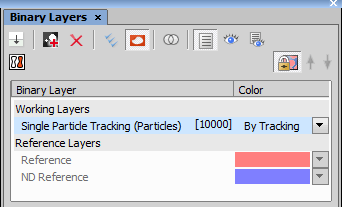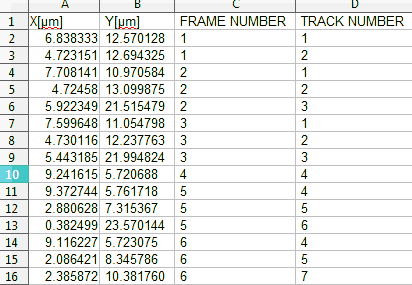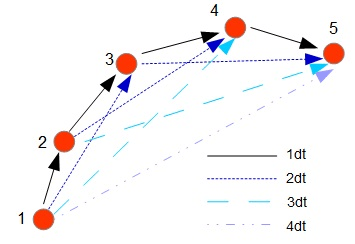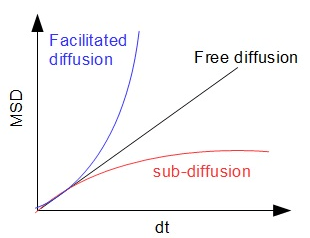Quit the preview mode and run the recipe on the complete movie by clicking .
Tracking on a single file creates an additional layer to the nd2 file. Layers can be be managed using Analysis Controls > Layer Management Tracking binary layer.
The quality of the tracking can be checked in the regular tracing window of NIS-Elements.
The tracking window enables to:
Select different traces and go to their corresponding frames.
Display statistics such a polar graph:
 .
.
Warning
Compared to other object tracking method, I-SPT tracks are expected to be short (2-6 frames). This is due to fast movement out of the 1µm focal depth of the system:
A two frames track is displayed as a “bar” in the tracking window.
Warning
Tracking windows does not only applies to single particle tracking but also to regular binary tracking of NIS-Elements. The button will track objects using regular tracking recipe and not SPT tracking plug In.
Batch processing produces I-SPT specific statistics. They include the mean square displacement (MSD).
Recipes can be run on a set of movies acquired for the same experiment.
In the Analysis Explorer, select  .
.
Batch processing produces two types of data file (.csv : coma separted values):
One csv file per movie with the particle coordinates.
One csv file per batch with the movie characteristics and statistics.
Movie specific file: “Name of the movie”.csv. It reports for each movie the X and Y particle coordinate frame number and particle ID.
Batch specific file: “Name of the movie”.csv.
Stat.csv summarizes global results per file.
Files shall have a low level of density (<1/µm / s) and low level of cut traces (<10%).
It includes:
File name.
Total number of detections.
Density.
Number of traces cut due to impossible matching.
Time and ensemble mean square displacement (MSD).
MSD is the standard statistic to investigate diffusion. For each traces it computes the displacements as a function of the time lag dt:
By plotting the average square displacement as a function of the time lag, we have an indication of the type of diffusion:
In the case of free diffusion, the slope of the MSD is equal to the diffusion coefficient D.
Warning
I-SPT tracks are too short to display their MSD. I-SPT computes a time and ensemble (all the traces) mean square displacement per file.







